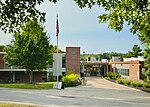Frederick Fiske and Gretchen Osgood Warren House
Buildings and structures in Harvard, MassachusettsHouses completed in 1894Houses on the National Register of Historic Places in Worcester County, MassachusettsShingle Style architecture in MassachusettsShingle Style houses

The Frederick Fiske Warren and Gretchen Osgood Warren House, known to the family as The Hutch, is a historic house at 42 Bolton Road in Harvard, Massachusetts. Built in 1894, it was the summer home of Frederick Fiske Warren and Gretchen Osgood Warren, who organized a major enclave of Georgist single tax properties in Harvard. The property was added to the National Register of Historic Places in 1996.
Excerpt from the Wikipedia article Frederick Fiske and Gretchen Osgood Warren House (License: CC BY-SA 3.0, Authors, Images).Frederick Fiske and Gretchen Osgood Warren House
Bolton Road,
Geographical coordinates (GPS) Address Nearby Places Show on map
Geographical coordinates (GPS)
| Latitude | Longitude |
|---|---|
| N 42.489166666667 ° | E -71.585 ° |
Address
Bolton Road 42
01451
Massachusetts, United States
Open on Google Maps










